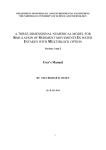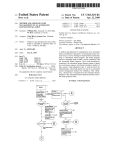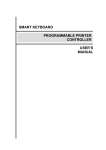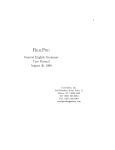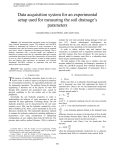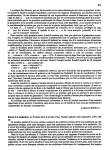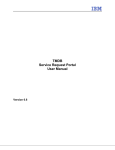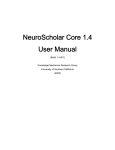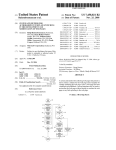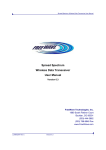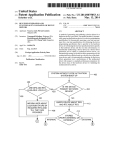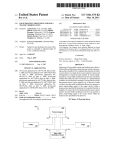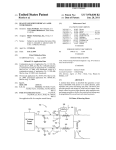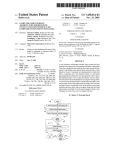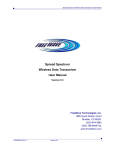Download Versatile page number detector
Transcript
US007797622B2 (12) Ulllted States Patent (10) Patent N0.: Déjean et a]. (54) US 7,797,622 B2 (45) Date of Patent: VERSATILE PAGE NUMBER DETECTOR Sep. 14, 2010 2006/0155703 A1 7/2006 Déjean et a1. 2006/0156226 A1 7/2006 Déjean et a1. (75) Inventors: Hervé Déjean, Grenoble (FR); Jean-Luc Meunier, St NaZaire les FOREIGN PATENT DOCUMENTS Eymes (FR) EP (73) Assignee: Xerox Corporation, NorWalk, CT (US) ( * ) Notice: W0 1603072 12/2005 WO 2005/119580 12/2005 Subject‘ to any disclaimer, the term of this OTHER PUBLICATIONS patent 1s extended or adjusted under 35 U_S_C_ 1540;) by 774 days_ Herve Dejean and Jean-Luc Meunier, Structuring Documents According to Their Table of Contents, Proceedings of the 2005 ACM (21) APPL NO; 11/599,947 Symposium on Document Engineering, Nov. 2-5, 2005, ACM Pub l1sh1ng, pp. 2-9.* NOV. 15, (65) (Continued) Prior Publication Data Us 2008/0114757 A1 Primary ExamineriDoug Hutton Assistant ExamineriAndreW R Dyer May 15’ 2008 (74) Attorney, Agent, or FirmiFay Sharpe LLP (51) Int. Cl. G06F 17/27 (52) US. Cl. ..................... .. 715/231; 715/230; 715/232; (2006.01) (57) 715/233. 715 03 4 (58) Fi61 d of Classi?cation Search ABSTRACT _ _ A method for detect1on of page numbers 1n a document $715030 includes identifying a plurality of text fragments associated 23 4 236’ With a plurality of pages of a document. From the identi?ed See application ?le for Complete Search hist’ory ’ text fragments, at least one sequence is identi?ed. Each iden ' References Cited ti?ed sequence includes a plurality of terms. Each term of the sequence is derived from a text fragment selected from the U‘ S‘ PATENT DOCUMENTS plurality text fragments. The terms of an identi?ed sequence comply With at least one prede?ned numbering scheme Which 56 5,699,453 A * 12/1997 Ozaki ....................... .. 382/176 de?nes a form and an incremental state of the terms in 21 5,940,583 A 8/1999 Taira et a1. sequence. A subset of the identi?ed sequences Which cover at 6,256,610 B1 * 6,839,848 B1 * 7/2001 Baum ....................... .. 704/260 1/2005 Kirikoshi et a1~ ~~~~~~ ~~ 726/2 least some of the pages of the document is computed. Terms of at least some of the subset of the identi?ed sequences are 2005/61195021332 : 2004/0088 1 65 Al * litur‘lieontetlal' 335882//13~ 2004/020837l A1,, 10/2004 Liu et a1 ' " 2005/0154979 A1 7/2005 Déjean et a1. 2006/0101058 A1 5/2006 Chidlovskii et a1. 2006/0155700 A1 7/2006 Déjean et a1. 382/173 more features of the terms in the subset of identi?ed 25 Claims, 5 Drawing Sheets 3 U2 tional page numbers may be identi?ed by considering one or Sequences" 1 1 construed as page numbers of pages of the document. Addi 5/2004 ofustzrrlieetaa'l """"" " 704/260 2/3 4 3/4 3/5 3/6 3/7 US 7,797,622 B2 Page 2 OTHER PUBLICATIONS Claus Gravenhorst; docWORKS/METAe The Engine for Automated Metadata Extraction and XML Tagging; CCS; Jul. 2004; p. 8.* US. Appl. No. 11/032,817, ?led Jan. 10, 2005, Déjean et al. US. Appl. No. 11/116,100, ?led Apr. 27, 2005, Déjean et al. US. Appl. No. 11/360,951, ?led Feb. 23, 2006, Meunier et al. US. Appl. No. 11/360,963, ?led Feb. 23, 2006, Meunier et al. X.Lin, Header and Footer Extraction by Page-Association, Inform a tion Infrastructure Laboratory, HP Laboratories Palo Alto, May 6, 2002, hpl.hp.com/techrepports/ZO02/HPL-2002-129.pdf, 2002. e.aib.uni.linZ.ac.at/metaeengine/engine/htrnl, Oct. 19, 2006. .ccs-grnbhde/indexiehtrnl, Oct. 19, 2006. PDF-Extraktor, .ovidius.com/en/tools/utilities/PDF-Extraktor, Oct. 3, 2006. T.J.Michalak, C.Madsen, M.Hurst, Harvard University Library Open Collections Program.‘ Final Report, Appendix A.‘ Description of CCS Doc WORKS Software and its E?ect on the OCP Production Worlg‘iow, http://ocp.hul.harvardedu/report/?nal/pagesf12.htn1l, Oct. 19,2006. * cited by examiner US. Patent Sep. 14, 2010 Sheet 1 of5 US 7,797,622 B2 l m L ‘ EONVERSION /14 PROCESSOR TEXT FRAGMENTER /‘6 0oz ‘ / A 24 18 PAGES AND TEXT BI-(KKS SCANNER A \ 4, TEXT FRAGMENT SEQUENCING MODULE 34 i \ V DIGITAL DOCUMENT SELEtTlON : : VERIFICATION 28/ MODULE MODULE <0RIGINAL PAGE N0.> 7 PAGE ASSOCIATION /3n MODULE 32 US. Patent Sep. 14, 2010 Sheet 2 of5 US 7,797,622 B2 S100 INPUT ORIGINAL DOCUMENT - $10? FRAGMENT TEXT OF ORIGINAL DOCUMENT / $104 PAGE sEouEIIcIIIG V 51°‘ \ > ENUMERATING sEnuEIIcEs OVER DOCUMENT ~—~ $108 DETERMINING SUBSET 0F sEouEIIcEs I” 511° ASSOGATE DETERMINED PAGE NUMBERS M’, 5112 WITH PAGEs OF DOCUMENT Y 5114 \\ N v VERIFICATION V FURTHER PROCESSING V '- $116 AIIIIoTATIoII 0E DOCUMENT WITH TAGs d’ 5118 REMOVAL OF PAGE NUMBERS FROM TExT ————~ 5'2" INDEX DOCUMENT ACCORDING if Sm To ORIGINAL PAGE NUMBERS DISPLAY ORIGINAL PAGE NUMBERS @ S126 FIG. 2 -—~~— 5124 US. Patent Sep. 14, 2010 Sheet 4 of5 US 7,797,622 B2 @ 5100 INPUT ORIGINAL D0cuMENT / 51 "2 FRAGMENT TEXT OF ORIGINAL D0cuMENT / 5104 PAGE sEDuENcING V ENuMERATE sEDuENcEs DvER DDcuMENT // S‘ “8 DETERMINE SUBSET 0F sEDuENcEs // 5110 WITH HIGH f VALUE v 5'06 \ ,/ 51 I4 ,/ sI I4A COLLECT IDENTIFIED PAGE NUMBERS / PEREDRM MAcIIINE LEARNING T0 DIsTINGuIsII PAGE NUMBERS FROM /’ / 5114B NON PAGE NUMBERS REPEAT sTEP 5108 WITH SUBSET DE sEDuENcEs AND NEWLY IDENTIFIED // 5114c T’ PAGE NUMBERS REPEAT STEP sIID WITH LOWER f VALUE TO DETERMINE //L’ S1140 OPTIMAL sET 0F TExT FRAGMENTS V AssocIATE DETERMINED PAGE NUMBERS WITH PAGEs 0F D0cuMENT V TD STEP S116 (FIG 2) FIG. 4 I,’ 51 12 US 7,797,622 B2 1 2 VERSATILE PAGE NUMBER DETECTOR addition, in the case of scanned documents, the position may vary due to translation or skeW betWeen scanned pages. Numbering schemes can also vary. Conventional number CROSS REFERENCE TO RELATED PATENTS AND APPLICATIONS ing schemes generally employ Arabic numerals, Roman numerals, or letters. HoWever, there are also page numbering schemes of the form N/ M, Where N is the page number and M is the total number of pages, or Where N is the section number and M the sub-section or page number Within the section. There are also composite page numbers of the form: TOC-N, INTRO-N, Where N is the page number, counted from the beginning of the document or of the section. There are also The following US. patent applications, Which are incor porated herein in their entireties by reference, are mentioned: Application Ser. No. 11/360,951, ?led Feb. 23, 2006, entitled RAPID SIMILARITY LINKS COMPUTATION FOR TABLE OF CONTENTS DETERMINATION, by Meu nier, et al.; Application Ser. No. 11/360,963, ?led Feb. 23, 2006, entitled TABLE OF CONTENTS EXTRACTION WITH schemes in Which the numbering is representative of the structure of the document, for example, some of the digits IMPROVED ROBUSTNESS, by Meunier, et al.; and Application Ser. No. 11/116,100, ?led Apr. 27, 2005, this type, the section number occupies 5 digits folloWed by the entitled STRUCTURING represent the section and others the page. In one scheme of DOCUMENT BASED ON TABLE OF CONTENTS, by Dejean, et al. BACKGROUND 20 The exemplary embodiment relates to the information stor body in a different manner, and any annex in another manner. age and processing arts. It ?nds particular application in conjunction With the conversion of documents available in print-ready or image format into a structured format that re?ects the logical structure of the document. Legacy document conversion relates to converting unstruc page number in the section. HoWever, even in such highly structured schemes, a different convention may be found in some sections. It is quite common to have multiple number ing schemes in use in the same document. For example, the front matter is partially numbered With Roman numerals, the Conventional approaches for applying page numbers Work at the page level. For pages missing a number, a human operator validates the output. 25 INCORPORATION BY REFERENCE tured documents existing in page description language for The folloWing published applications and patents, Which mats such as Adobe’ s portable document format (PDF), Post Script, PCL-5, PCL-5E, PCL-6, PCL-XL, and the like, into structured documents employing a markup language such as 30 are incorporated herein in their entireties by reference, are mentioned: extensible markup language (XML), standard generaliZed Published Application No. 2006/0156226, published Jul. markup language (SGML), hypertext markup language 13, 2006, entitled GLOBAL APPROACH FOR HEADER/ FOOTER DETECTION, by Déj ean, et al., discloses a method (HTML), and the like. Such structure can facilitate storage and access of the document. The particular motivations for converting documents are diverse, typically including intent for identifying header/footer content of a document in order 35 blocks as derived from the document. Header/footer Zones to reuse or repurpose parts of the documents, desire for docu ment uniformity across a database of stored information, facilitating document searches, and so forth. Technical manu are de?ned by textual content having a loW textual variability. An alternative embodiment identi?es pagination constructs by comparing selected text-boxes for similarity and proxim als, user manuals, and other proprietary reference documents are common candidates for such legacy conversions. 40 prise pagination constructs. Published Application No. 2006/0155700, published Jul. eated sections such as document pages With suitable headers/ footers and so forth. Such organiZation typically is imple mented using markup tags. In some structured document 45 similar document portion provides overall information about the document, such as an identi?cation of the sections, and facilitates complex document structures such as nested sec tions. Issues arise in reconstructing conventional constructs such ments in a marked-up format such as extensible markup lan 50 ferent positions in the various parts of the document, for example, a different position in the preface from that of the guage @(ML). Published Application No. 2006/0155703, published Jul. 13, 2006, entitled STRUCTURING DOCUMENT BASED ON TABLE OF CONTENTS, by Déjean et al., and Published Application No. 2006/0155703, published Jul. 13, 2006, 55 entitled METHOD AND APPARATUS FOR DETECTING A TABLE OF CONTENTS AND REFERENCE DETERMI NATION, by Dejean, et al., relate to methods for identifying a table of contents in a document. Published Application No. 2005/0154979, published Jul. can vary from one document to another and even Within the same document. Layout may also vary. In some documents, the page numbers may alWays appear at the same position on the page, or they may change position on odd/ even pages. In other documents, the page numbers may have a different place for the ?rst page of each section, or have various dif 13, 2006, entitled METHOD FOR STRUCTURING DOCU MENTS BASED ON THEIR LAYOUT, CONTENT AND COLLECTION, by Dejean, et al., relates to document format conversion and in particular to the cataloging of legacy docu as titles, headings, captions, footnotes, and the like, in par ticular, the detection of the page numbers of a document. One dif?culty With the versatile detection of page numbers resides in the Wide variability of their appearance, layout, and num bering scheme Within a document, over a collection, and from collection to collection. For example, in the case of appear ance, the font type, font siZe, and font color of page numbers ity and clustering the text boxes satisfying a predetermined similarity value. The clustered text boxes are deemed to com In structured documents, content is organiZed into delin formats, such as XML, a document type de?nition (DTD) or to sequence text fragments comprising recogniZable text 14, 2005, entitled SYSTEMS AND METHODS FOR CON 60 VERTING LEGACY AND PROJECTING DOCUMENTS INTO EXTENDED MARKUP LANGUAGE FORMAT, by Chidlovskii, et al.; Published Application No. 2006/010105 8, published May 11, 2006, entitled SYSTEM AND METHOD FOR TRANSFORMING LEGACY DOCUMENTS INTO table of contents, the body, or the annexes. Sometimes the XML DOCUMENTS, by Chidlovskii, et al., disclose conver sion of legacy and proprietary documents into extended position of the page number is different for each chapter. In mark-up language format. 65 US 7,797,622 B2 4 3 PCT Published Application No. WO 2005/119580, pub fragment term for the sequence for that page, and e) option lished Dec. 15, 2005, entitled METHODAND DEVICE FOR THE STRUCTURAL ANALYSIS OF A DOCUMENT, by Ralph Tiede, discloses a method for the structural analysis of minimum density, closing the existing sequence against addi ally, for each sequence Which does not meet a prede?ned tion of fragment terms from subsequent pages of the docu ment, the prede?ned minimum density being a function of a a document. The method includes reducing a draft to elemen tary structural units and producing generic objects therefrom. total number of terms in the existing sequence and a total number of holes in the existing sequence. The method further includes computing a subset of the sequences, optionally, extrapolating sequences of the subset to identify terms for holes in the sequences and optionally, identifying additional text fragments of the document as potential page numbers by comparing features of the additional text fragments With fea tures of the text fragments of the identi?ed sequences. Terms of the subset of sequences and optionally also terms of the One or more properties are allocated to the generic objects and a structure, Which reproduces the draft, is produced in an electronic format by means of the generic objects. US. Pat. No. 5,940,583 by Taira, et al. discloses a copying apparatus Which reads an original With an image reader. If captions are recogniZed in the original, the apparatus stores a page number of the original into a memory, thereafter, per forms copying based on the stored page number such that the original page including the caption is transferred onto the front side of a recording sheet. additional fragments are construed as page numbers of pages BRIEF DESCRIPTION In accordance With one aspect of the exemplary embodi 20 ment, a method for detection of page numbers in a document includes identifying a plurality of text fragments associated With a plurality of pages of a document. From the identi?ed text fragments, at least one sequence is identi?ed. Each iden ti?ed sequence includes a plurality of terms: Each term is derived from a text fragment selected from the plurality text 25 of the document. In accordance With another aspect, a method for detection of page numbers in a document includes identifying a plural ity of text fragments associated With a plurality of pages of a document. From the identi?ed text fragments, at least one sequence is identi?ed. Each identi?ed sequence includes a plurality of terms. Each term is derived from a text fragment selected from the plurality text fragments, the terms of a sequence complying With at least one prede?ned numbering fragments. The terms of an identi?ed sequence comply With at least one prede?ned numbering scheme Which de?nes a scheme Which de?nes a form and an incremental state of the terms in a sequence. A subset of the sequences is computed, form and an incremental state of the terms in a sequence. A subset of the identi?ed sequences Which cover at least some 30 including scoring nodes of the sequences based on a length of of the pages of the document is computed. Terms of at least the sequence as a function of a ?rst length factor. Each term in some of the subset of the identi?ed sequences are construed as the sequence is represented by a separate node. A model is page numbers of pages of the document. In accordance With another aspect, a system for detection of page numbers includes memory Which stores instructions developed for identifying additional text fragments as poten 35 for (a) identifying a plurality of text fragments associated With a plurality of pages of a document, from the identi?ed text fragments, (b) identifying at least one sequence, each identi?ed sequence comprising a plurality of terms, each term derived from a text fragment selected from the plurality text fragments, the terms of a sequence complying With at least one prede?ned numbering scheme Which de?nes a form and an incremental state of the terms in a sequence, (c) computing a subset of the identi?ed sequences, and (d) construing terms of the subset of sequences as page numbers of pages of the document. A processor executes the instructions. In accordance With another aspect, a method for detection of page numbers in a document includes identifying a plural ity of text fragments associated With a plurality of pages of a document, each of the identi?ed fragments including a term 40 sequences and additional text fragments is computed, includ ing scoring nodes of the sequences and additional text frag ments based on a length of the sequence or additional text fragment as a function of a second length factor Which is more 45 BRIEF DESCRIPTION OF THE DRAWINGS 50 FIG. 1 is a functional block diagram of an apparatus for detection of page numbers of an original document in accor dance With one aspect of the exemplary embodiment; 55 aspect of the exemplary method; scheme for the existing sequence and ?ts an incremental state FIG. 3 illustrates the application of an algorithm to an eight sequence Will accept a text fragment, adding the term of the page document shoWing four states comprising sequences; 60 aspect of the exemplary method; Which includes the text fragment term, the neW sequence serving as an existing sequence for a subsequent page of the no text fragment term is added for the page, feeding the sequence With a hole Which designates the absence of a text FIG. 4 is a ?owchart for a method of detection of page numbers of an original document in accordance With another added to any of the existing sequences, start a neW sequence document, d) optionally, for each existing sequence to Which FIG. 2 is a ?owchart for a method of detection of page numbers of an original document in accordance With another for the existing sequence, b) for each existing sequence, if the text fragment to the existing sequence and incrementing its state, c) for each identi?ed text fragment that has not been prone to accept shorter sequences than the ?rst length factor and construing at least some of the terms of in the optimal set as page numbers of pages of the document. Which complies With a form of at least one prede?ned num bering scheme. For each page of the plurality of pages in turn: a) for each identi?ed text fragment of the page, determining Whether an existing sequence Will accept the text fragment, a sequence only accepting a text fragment if the text fragment ?ts With the form of at least one prede?ned numbering tial page numbers, the model being based on at least one feature of at least one text fragment from Which the terms of the ?rst subset of sequences are derived. The model is applied to at least some of the identi?ed text fragments in the docu ment to identify additional text fragments that are potential page numbers. An optimal set of terms from the subset of the FIG. 5 schematically illustrates pages of an original docu 65 ment and terms of a sequence identi?ed for the pages in a modi?cation to the exemplary method in Which a sequence is terminated once it becomes too sparsely populated; and US 7,797,622 B2 6 5 ments generated by optical character recognition (OCR) soft FIG. 6 illustrates areas of a page Which are considered as sources of terms of a page number sequence in accordance Ware Where page numbers are small and the layout informa With one aspect of the exemplary embodiment. tion provided by OCR engines is frequently unreliable. In the exemplary method, an intrinsic property of the page numbering for a document is exploited in a ?rst stage. Spe ci?cally, the numbering forms an increasing sequence of DETAILED DESCRIPTION The exemplary embodiment provides a system and method terms, one perpage, or more generally it is constituted by a set for detection of page numbers of an original document. The of non-overlapping increasing sequences. This functional approach is independent of any layout or typographic char method may include identifying text fragments of pages of the document and determining Whether any of the identi?ed acteristics and can therefore cope seamlessly With the vari fragments form a sequence covering tWo or more pages. In ability typically found in such documents. In a second, particular, the method may include identifying text fragments optional stage, layout and typographic information may be associated With a ?rst page of a document (or prede?ned employed to improve further the precision and/ or recall of the region thereof) and determining Whether any of the identi?ed exemplary method. text fragments is or includes a term Which complies With a A digital document may be considered as a set of pages, each page containing a set of text fragments. For some pages, the set may of course contain no text fragments, either because the page is blank or because it includes images not prede?ned numbering scheme and if so, considering the terms of these text fragments as potentially part of a number ing sequence. On the next page of the document, text frag ments are identi?ed and a determination is made as to Whether any of these identi?ed text fragments includes a term Which recogniZed as text. A text fragment typically corresponds to a 20 complies With a prede?ned numbering scheme. For each of includes one of the terms of the text fragments already iden ti?ed for the ?rst (and/or a previous) page and if so, the text 25 fragment is added to that sequence. Any of the text fragments comprising terms complying With a numbering scheme but Which does not ?t a numbering sequence Which includes a term from one of the text fragments from the previous page(s) is considered as potentially a part of a neW numbering 30 sequence. The method is repeated for each page for all pages of the document, With terms being added to existing sequences, as appropriate, and neW sequences started Where a term does not ?t With an existing sequence. An optimal subset of the identi?ed sequences is then computed Which covers at best the entire document (i.e., at best, one term of the sequence per page of the document). The terms of the optimal subset of sequences may then be construed as being the page numbers of pages of the document. Additional page numbers may be detected by comparing appearance or position fea tures of the text fragments in the document With those of text fragments from Which the terms of the optimal subset are derived. The exemplary system includes a processor Which executes instructions for performing a method for detection of page numbers on an input document. The detection of page numbers is advantageous in a num ber of instances. First, it may be of bene?t to remove the page numbers from a document. This may be used in the transfor Word or in some cases a line or a part ofa line. This is a model that ?ts Well With the output of PDF-to-XML converters or those terms Which do, a determination is also made as to Whether the term ?ts a numbering sequence Which also 35 With OCR engines. The digital document typically includes text fragments Which comprise the original page numbers for the document. HoWever, in many instances, the original page numbers may be different from the page position in the docu ment. For example, a chapter of a book Which has been scanned and OCR processed may have tWelve pages, hoW ever, the original numbers of these pages in the book may be 559-570. In general, the original document is in an unstructured format, Which in the present case means that the text portions may include page numbers but the structure of the document does not identify them as such. In converting the unstructured document to a structured digital document, the original page numbers become part of the text, but are not identi?ed as being page numbers in the document structure. The exem plary system and method seek to identify the original page numbers for further processing, e.g., tagging, indexing, and/ 40 or removal. The original document may be a page description language document, such as a PDF, PostScript, PCL-5, PCL-5E, PCL 6, PCL-XL or other suitable document. In PDF, for example, portions of text and other document content, such as images, 45 are in the form of objects Which are assigned to pages of the document by a job ticket. In general, the page numbers may form a part of one or more of the text objects. The job ticket may be associated With the ?le as a ?le header or embedded in to index the pages of a document by their printed page num the document. The structured format to Which the original document is converted may be any suitable markup language, such as XML, SGML, XML, HTML, or the like. XML alloWs the delivery of structured data in a standard, consistent Way. ber. Typically, this is the case in the digital library domain XML is a complementary format to HTML and both are mation of the set of pages of a document into a continuous How of text, Without any pagination element, and in particular Without the original page numbers. Second, it may be useful Where the page numbers remain an important means for navi gating a document. Third, it is common for a feW of the pages in a document not to shoW any number despite being part of a certain numbering sequence. It may be desirable to have each page of the document numbered, e.g., in a vieWable format, according to the sequence. Rather than detection of page numbers solely at the page level, the exemplary system and method enables detection of page numbers at the document level and thereby can avoid the need to rely primarily on the layout or appearance related properties of the page numbers for their detection. The method is particularly useful in cases Where page numbers extracted from an original document are unreliable, such as When processing a document collection or processing docu 50 derived from the Standard Generalized Markup Language 55 (SGML); hoWever, unlike HTML, XML does not have a ?xed vocabulary. SGML and XML, for example, are both text-based formats that provide mechanisms for describing document structures using markup elements or tags (Words surrounded by “<” and 60 “>”). For example, in one embodiment, once the page number has been identi?ed, a page number may be identi?ed Within the text by <pagenumber>6</pagenumber> , for page 6 of the document. The numeral 6 may appear in the printed or on 65 ally remains hidden to the vieWer but serves to identify the numeral 6 as a page number during searching (for example, a vieWer may request a search tool to “go to page 6”). screen displayed document, While the <pagenumber> gener US 7,797,622 B2 7 8 In embodiments Where the page numbers are to be removed from the text, once the page number is identi?ed, the struc graphic memory. In some embodiments, the processing mod ules 14, 16, 26, 28, 30, 34 and memory 36 may be combined tured format may be free of embedded page tags. Alterna tively, a page number tag Which identi?es the removed page number may be embedded in the appropriate text object, or otherWise associated thereWith, such as <page number value:“6”/>. in a single chip. A user interface 38, such as a keyboard, touch screen, cursor control device, or combination thereof, permits interaction of a user With the assembly 1. The exemplary assembly 1 may be implemented in a com puting device, such as a general purpose computer or a dedi cated computing device. The computer may be a PC, such as FIG. 1 shoWs an assembly I Which includes a processor 10 a desktop, a laptop, palmtop computer, portable digital assis comprising a plurality of processing modules for automated processing of an input digital document. An unstructured tant (PDA), cellular telephone, pager, or other suitable pro cessing device. The various components of the computer may be all connected by a bus (not shoWn). As Will be appreciated, only a portion of the components Which are incorporated into document 12, e.g., a technical manual, user manual, other proprietary reference document, or the like in a PDF format, is converted by conversion processor 14 into an alternative language format, such as XML or other structured format, and When in such format can be processed for various pur a computer system are shoWn in FIG. 1. Since the con?gura tion and operation of programmable computers are Well knoWn, they Will not be described further. Further processing may be undertaken on the documents output by the page poses as a legacy document. The converter 14 may be an off-the-shelf converter Which converts the input original document into a list of text strings from an XML ?le produced from the original document. A text fragmenter 16 breaks the converted document into an ordered sequence of text frag 20 ments 18. In the case of a physical document, such as a paper document 20, the document is suitably scanned using an optical scanner 22 and processed by an optical character recognition (OCR) processor 24 to form the digital document. For a text document, each line may become a fragment, ordered line-by-line. For an XML or HML document, text 25 fragments may be based at the Word level, Where each Word is a control program is recorded, or may be a transmittable carrier Wave in Which the control program is embodied as a generally distinguished from adjacent Words by a space data signal. The illustrated method may be entirely automated (Words here can include one or more recogniZed characters of any type, including letters and/or numbers). Fragmenter 16 30 or may include some user input, as noted herein. The method begins at step S100. At step S102, an original document, 12, is converted to a structured format. At step S104, the converted document is fragmented into text fragments. Depending on the nature of the document, the may also effect a position allocation of the document text content so that the page segmentation and vertical positions per page of the text content are preserved. For plain text format, the vertical position used is a line number. For a proprietary format, the document can be converted into plain association module. With reference to FIG. 2, an exemplary method Which may employ the assembly of FIG. 1 is illustrated. It is to be appre ciated that the exemplary method may include feWer, more, or different steps from those shoWn and need not proceed in the order illustrated. The method illustrated in FIG. 2 may be implemented in a computer program product that may be executed on a computer. The computer program product may be a tangible computer-readable recording medium on Which 35 text fragments may be a line of text, a portion of a line, or a text format, or can be converted into a format Where informa single Word. The fragments are identi?ed by the page on tion about the vertical position exists. For example, a PDF2XML converter can provide page segmentation and positional information of the blocks of texts. A text fragment sequencing module 26 identi?es text frag Which they are found, Where each page generally corresponds to a page of the original document. At step S106, text fragments are examined to determine 40 ments representative of an increasing series by applying rules particular, the system relies on a stored set of numbering schemes, such as Arabic, Roman, and the like. The set of Which de?ne one or more numbering schemes. In particular, the sequencing module 26 seeks a sequence of text fragments forming an increasing series and covering at best the Whole document. In general, a plurality of such sequences may be identi?ed. A selection module 28 selects an optimal sequence or group of sequences by application of de?ned selection criteria. A page association module 30 may tag the pages of the document With tags 32 based on the terms of the optimal sequence or otherWise annotate the document With informa numbering schemes is extensible since a neW scheme must simply conform to a simple programmatic interface, dis 45 sequences (S108), optimiZing (S110), optionally veri?cation (S112), and page association (S114). These steps may be 50 performed as a sequence or in one or more return loops. At step S108, sequences occurring over consecutive document pages of text fragments that (a) all belong to the same num bering scheme (eg all Roman numerals) and (b) Which form an incremental sequence, are identi?ed. This step may com 55 the like may also be stored in memory 36. The memory 36 may represent any type of computer readable medium such as random access memory (RAM), read only memory (ROM), magnetic disk or tape, optical disk, ?ash memory, or holo prise identifying all possible such sequences of tWo or more text fragments. At step S110, an optimal subset of non-overlapping or identify additional page numbers for pages Where no page number Was previously identi?ed. Each ofthe processing modules 14, 16, 26, 28, 30 and 34 may execute instructions for performing the exemplary method described in greater detail beloW, Which may be stored in associated memory 36. Text fragments, documents, identi?ed sequences, rules de?ning numbering schemes, and cussed beloW. For any given set of numbering schemes, the sequencing step S106 may employ three or four substeps: enumerating tion based on the output of the sequencing module 28. Alter natively, or additionally, the page association module 30 may implement another automated process, such as removal of the identi?ed fragments Which comprise the selected sequence. Optionally, a veri?cation module 34 implements veri?cation steps to con?rm the previously identi?ed page numbers and/ Whether they represent a sequence over tWo or more pages. In sequences is selected so as to cover at best the entire docu ment by applying a scoring function to the identi?ed 60 sequences. At step S112, each page is associated With its correspond ing term in the sequence that Was selected for that part of the document. Step S112 may further comprise extrapolating the sequence for any missing numbers. At the end of stage S112, 65 there may still be pages for Which no term is assigned. At step S114, further processing of the document may optionally occur for veri?cation of the optimal sequence and/ US 7,797,622 B2 9 10 or identi?cation of missing page numbers. In one embodi ment, this step is only performed if there are pages for Which the optimal sequence(s) identi?ed at step S110 is missing one or more page numbers (holes). In another embodiment, step S114 may be performed irrespective of Whether any holes are identi?ed. Following step S114, steps S110 and S112 may be repeated and a neW optimal sequence established. Optionally, numerals (all of Which Will be referred to generally as num bers), Which de?ne an ordered sequence: 1. Arabic numerals: the syntactic form is a series of digits and the constraint for this numbering scheme is to observe a +1 betWeen consecutive terms of the sequence corresponding to consecutive pages. Missing numbers are accepted and taken into account for the +1 constraint. Extrapolation for Where step S114 is performed, step S114 precedes step S112. At step S116, a computer implemented step may be initi missing numbers is also possible. Examples of this number ing scheme include sequences such as 1, 2, 3, 4, and 66, 67, ated, based on the output of step S112 and/or S114. This 68, 69, i, 71, Where “_” represents a hole. 2. Roman numerals: the syntactic form is a series of roman numerals: i, ii, iii, iv, etc. in either upper or loWer case, and the constraint for this numbering scheme is the same as that further processing step may include one or more of: a) annotating the document or pages thereof (step S118), e. g., With XML tags comprising information derived from the assigned terms, observed for the Arabic numerals to Which they correspond (i:1, ii:2, etc), as described above. 3. Single letters: the syntactic form is a series of letters, b) removing some or all of the identi?ed sequence of terms corresponding to the original page numbers from the digital document (step S120), such as a, b, c, d, generally of the same case (i.e., upper or c) indexing the document according to the identi?ed loWer case letters) and the constraint for this numbering sequence of terms corresponding to the original page num bers from the digital document (step S122), and 20 scheme is to observe a +1 in the normal alphabet sequence betWeen consecutive terms of the sequence corresponding to d) displaying some or all the terms on the digital document consecutive pages. In some embodiments, a sequence x, y, Z, (step S124), in particular for those pages Where the original a does not comply With the constraints, although in other embodiments, this may be permitted. Missing letters are accepted and taken into account for the +1 constraint. page number is missing or appears to be missing. The method ends at step S128. It Will be appreciated that further processing steps may be performed on the structured document, in addition to those described, such as identi?ca tion of chapter headings and/ or subheadings and annotating the document With tags corresponding to the headings and/or indexing the headings according to the page numbers of the original document, displaying a table of contents according to the page numbers of the original document, and the like. 25 any composition of Arabic/Roman/ letter numbers, such as a numbering scheme “1 .3.2, 1.3.2, 1.3.3, etc.,” or “toc-1,toc-2, 30 The assumption that the tWo constraints placed on the 35 are enough to determine the page numbering, independently of the position and appearance of these numbers proves to be reliable in practice, although in some cases, improvements may be achieved by the optional added veri?cation step (step S 114). Numbering Schemes Numbering schemes may be de?ned generally as having a de?ned form and a de?ned incrementality. By “form,” it is meant that a numbering scheme de?nes the syntactic form of the page numbers it Will accept. For example, the Arabic scheme syntactic form consists of a series of digits. By “incre toc-3,” or “A-5, A-6, A-7.” Such a numbering scheme may accept values formed of any string constant(s), separator(s), and one or several Arabic/Roman/Letter value(s). In practice, fragment sequences in step S108 (same numbering scheme and incrementality) conjugated With an optimal selection of sequences to cover at best the Whole document in step S110 Extrapolation for missing numbers is also possible. 4. Composite numbering: this numbering scheme targets the possible separators are de?ned by a regular expression, such as: [\|\t|\.|,|;|:|V\%|&|\*|\-|_|\+]+. A fragment is token iZed accordingly and tokens are matched against the Arabic/ Roman/Letterfamily. Any non-matching token is considered as a string constant for the sequence. In turn, the ?rst observed page number of such a sequence dc?ncs a sequence prototypc composed of separators, number family, and string constants 40 (i .e. anything that is neither a separator nor anArabic/Roman/ letter number). It de?nes the syntactic form for all remaining terms of the sequence. Missing numbers may be tolerated. For example, a composite sequence initiated for the term “TOC-l” may de?ne a prototype such as: <string-constant> 45 TOC. <separator>—<Arabic>. As for the increase constraint, a valid fragment may be mapped to a strictly positive integer, i.e., [1 , +OO[For example, the number value may be considered mentality,” it is meant that an instance of a numbering scheme as a value expressed in any convenient base, such as base holds a state that enforces an increase of the page number over a sequence of pages. It may or may not tolerate some holes in 50 a sequence, each hole corresponding to a page of the struc 10000 (Which ignores Arabic/Roman/ letter values above 9999). Such a simpli?cation is not generally damaging for most applications although higher bases may be employed if tured document Where no page number is found. appropriate. Where the numbering scheme is knoWn to com prise feWer numbers, a loWer base may be employed. Where holes are tolerated, extrapolation for missing values Extrapolation for missing numbers in composite number may be performed. Extrapolation generally includes assign ing a page With a hole, the next value in the sequence to that 55 ing schemes may be more di?icult than for simpler number ing schemes. HoWever, it may be possible in certain simple of the preceding page Where the form of the sequence permits extrapolation of the sequence With an acceptable degree of con?dence. The acceptable degree of con?dence may depend Which is based on a set of characters (often referred to as cases. For instance, extrapolating for (1.1, 1.2, i, 1.4) is straightforward, While on the contrary, the number betWeen 1.2.3 and 2.1.1 cannot be extrapolated. 5. Generic Ascii family: in this case the numbering scheme accepts any string that starts With an alphanumeric character and Wherein all strings have all the same length as the ?rst accepted fragment. The increase constraint consists of check ing that tWo consecutive terms are strictly equal apart for one character that obeys a+1 (in terms of ascii/unicode numerical code). In general, the transition from, for instance, AZ to BA parsable character data (PCDATA)), such as letters and/or does not ?t With the constraint and a neW sequence Will be on the ultimate use of the information. The con?dence level may be higher When the sequence terms for the adjacent preceding and subsequent pages are identi?ed and is particu larly high When the incremental state accepts only one pos sible value for the page With the hole. In one embodiment, the set of numbering schemes includes some or all of the folloWing numbering schemes, each of 60 65 US 7,797,622 B2 11 12 started for BA, BB, BC, etc. Missing numbers may be toler ated in this numbering scheme. Extrapolation is not generally Dealing With holes improves the accuracy of the method because they are commonly observed in many documents. In addition, it is particularly bene?cial When processing OCR possible. The ?rst four schemes cover a large part of the documents ed documents: page numbers are often small elements that are usually encountered, While the last (general ascii) is su?i regularly missed or badly recogniZed by OCR engines. Gen ciently generic that it covers most cases. The ?rst four erally, holes may be dealt With due to the startPage/endPage methods, rather than via the last for each construct in the schemes have quite a strict and precise increase constraint While the latter is both looser and less precise, and therefore more subject to noise. A fragment may therefore be checked against these families in the order they are presented above to minimize the effects of noise. As Will be appreciated, addi tional numbering schemes may be de?ned and added to the pseudo code above. To assist in evaluating sequences, the coverage and length of a sequence may be de?ned as folloWs: the “coverage” of a group of schemes at any time. For example, if a document or group of documents is expected to folloW a specialiZed num sequence is the set of pages inclusively betWeen the ?rst and last page Where a fragment of the sequence (a term) Was observed. The “length” of a sequence is the number of bering scheme, constraints for this scheme may be added to the group of numbering schemes to be checked and applied to each fragment early on in the order. Additionally or alterna tively, if some of the numbering schemes are found to gener ate too much noise or otherWise be inappropriate, they may be dropped from the group for certain classes of documents. number of holes of a sequence equals the cardinal number of its coverage. For example, a sequence comprising four terms and tWo holes has a length 4 and a coverage cardinal number of 6. In general, the sequence begins and ends With a term. Thus, holes, Where present in a sequence, are bounded by observed terms in it. By construction, the length plus the 20 In one embodiment, a class NumberingScheme may be terms. de?ned Which de?nes a plurality of numbering schemes, such as some or all of the ?ve schemes described above. The method at step S108 may include the following: 1. A class method “?t” that checks Whether or not a frag ment ?ts With the scheme’s form. 25 are called before and after processing a page and that let 30 fragment is acceptable by a sequence in vieW of its 35 in terms of length and/or coverage may be eliminated from consideration. The rules governing the selection of an optimal set of sequences may include assigning to each term and/or each sequence a score Which re?ects hoW Well the term and/or sequence ?ts With predetermined selection criteria. For example, longer sequences may score higher than shorter ingScheme. This design readily alloWs the incorporation of a neW family, if required. The steps of the exemplary method Will noW be described in further detail. In the enumeration step (S108), a search is made for all possible sequences of terms that Would ?t With one (or more) of the de?ned numbering schemes. For comprising terms from tWo or more selected sequences). In some embodiments, sequences Which are beloW a threshold internal state. 4. An instance method “extrapolate” that delivers a real or an extrapolated page number for a physical page. 5. Any neW family is a specialiZation of the class Number applies a set of rules to select one or more sequences of terms from those sequences identi?ed at step S108. The rules gen erally favor the selection of longer sequences over shorter ones and avoid or prohibit the overlap of sequences (pages 2. TWo instance methods “startPage” and “endPage” that a sequence object of that family deal With its incremental state and the possible holes in the sequence. 3. An instance method “accept” that checks Whether a The selection step (S110) Will noW be described in greater detail. This step includes selecting an optimal subset of the identi?ed sequences. Speci?cally, the selection module 28 ones and sequences With feWer or no holes may score higher 40 than those With a greater number of holes. The numbering scheme may also impact the score. For example, Roman or Arabic numbeing schemes may be scored more highly than example, a greedy enumeration is performed, considering all general ASCII. In one embodiment, an algorithm, such as a pages in turn and all text fragments per page in order to enumerate all sequences that it is possible to make With the text fragments of the document, over a consecutive set of pages. The code of one exemplary algorithm can be repre sented in abbreviated form as folloWs: Viterbi shortest path algorithm, is used to select the best 45 subset of sequences based on the scores assigned by the scoring function. In particular, each page is associated With N+l states, Where N is the number of sequences covering that page (i.e., the page is in the coverage of the sequence). The additional state simply re?ects an absence of a page number 50 START, With an empty set of sequences of observed fragments Foreach page in turn: Foreach text fragment of the page: Foreach sequence: If the text fragment ?ts With the sequence’s form and sequences are identi?ed (Seq. l, Seq. 2, Seq. 3, and Seq. 4). The sequences are arranged in a matrix With the x axis cor 55 incremental state: Then feed this sequence With this observed text fragment if the text fragment has not been consumed by any sequence: Then: Foreach numbering scheme: If the text fragment matches the numbering scheme’s form: 60 Then start a neW sequence of that numbering responding to the number of pages in the document and the y axis, the sequences. The arroWs in FIG. 3 indicate all possible transitions, given the requirement that a sequence can be taken only at its starting point. Each term or hole of a sequence is represented by a node 38. To initialiZe the matrix, each node 38 is assigned a score, for example, using a scoring function. The score of a path from the beginning to the end of the document is the sum of the score of the visited nodes. To favor longer sequences, the score of a node representing a scheme and feed it With this observed fragment Foreach sequence: If the sequence did not consume any text fragment on this page: feed it With a “hole” for a page (a hole). By Way of illustration, FIG. 3 simulates the application of the algorithm to an eight page document Where four possible term generally increases With the length of its associated 65 sequence. The score of a hole may be loWer than the score for a term, e.g., Zero. In general, all term nodes of a sequence Which are traveled in a given path have the same score. Where US 7,797,622 B2 13 14 a sequence is only partially traversed, the scoring function ing Without consideration of any positional/appearance fea tures information and Which optionally exploits this information in a second stage (veri?cation step S114) pro may be recomputed to account for the shorter length of the sequence. Various scoring functions are possible. In one embodi vides more useful results. It is also contemplated that a con sideration of positional/appearance features information may ment, a scoring function of the following form is used: be utiliZed in scoring the terms of an enumerated sequence Where f is a constant, Which is referred to herein as the length factor. (step S112), as discussed in further detail beloW. As noted above, an optional veri?cation step S114 may be employed Which utiliZes additional information from the document to verify the selected sequences and/or identify additional terms. For example, the method may include ?nd ing regularities among the detected page numbers With respect to their typography and/ or position. This can be per The length of the sequence (of Which the node to be scored forms a part) is as de?ned above, except in that When only a formed, for example, by using data clustering methods. In one embodiment an agglomerative complete link clustering portion of the sequence forms a part of the path, only that method may be separately performed on groups of pages, such as on i) all odd pages, ii) even pages, iii) all pages). Once a regularity is established Which enables the page numbers to d “creme e) = l — i lengtl?sequence) portion is used in determining the length. The length factor f may have any suitable value. In general, higher values of f increase precision, but may have an adverse affect on recall. For example, When f is 2, the score for each node is Zero for a sequence having tWo terms. In one embodiment, f may be at 20 be distinguished With an acceptable reliability from other text, it may be used to identify characters representing page numbers for those pages for Which no page number has least 1, for example, from about 1.5 to 5, although higher already been assigned. Additionally, or alternatively, the values may be appropriate in some cases. An advantage of this regularity may be used to identify any term from any enumer type of scoring function is that it discards any sequence shorter than f since its nodes are accorded a negative score. In 25 addition, When the path through the matrix leaves a sequence before its end, it is easy to correct the previously computed score to account for the skipped observations. For example, if a path leaves a particular sequence after M nodes, skipping N nodes, then for the above scoring function, the scores may be Where the Viterbi algorithm is rerun by reapplying the algo rithm to the enumerated sequences, as modi?ed by step S114. 30 recomputed by subtracting N.f/(N+M) from the score Which Was originally accorded to node M to account for a reduced effective length of the sequence. In this Way, the Viterbi shortest path algorithm retains its advantageous property of only needing to look at the current set of states. To compute the optimal score, a path may be traversed Step S112, Which includes associating page numbers to each page, is simply achieved by choosing the best (highest scoring) path. In the case of the matrix shoWn in FIG. 3, assuming that f is 2.5, the best path Will most likely be the one Which includes sequences 1 and 4, since this path utiliZes the use of a veri?cation step may lead to improvements in the accuracy of page detection, particularly on collections Where many short sequences appear. HoWever, in some collections, it may not provide a bene?t or may yield a decrease in the accuracy. In one embodiment, a supervised machine learning 40 approach may be exploited to improve the veri?cation stage (step S114). The numbers detected in the main, “functional”, approach may be used as a training set With a featureset based on typography and position. The ?rst and second stages thus rely on different properties of the text fragment. 45 noted above, some page numbering schemes permit extrapo on a document up to step S110, as for the method of FIG. 2, 50 pleted in an automatic Way. The exemplary embodiment provides a sequence-based approach for detecting page numbers Which builds on the intrinsic property of the page numbering of a document and Which can be divorced from any positional features and/or For example, a method Which employs such a machine learning approach is illustrated in FIG. 4. The method of FIG. 4 is particularly suited to identi?cation of sequences having feWer than f terms. First, the exemplary method is performed tWo sequences With the highest coverage and also avoids leaving any sequences midWay. The terms of these sequences may thus be used as the original numbers of the document. As lation. In such cases, any holes in the sequence can be com This second, or any subsequent rerunning of the Viterbi algo rithm, may be performed With a smaller length factor f than Was used in a prior execution of step S110. For example, the length factor for the repeat of step S110 may be about 0.5. The 35 from its terminal (last) node back to the ?rst node in the path. At each node, the path Which yields the highest score is generally folloWed. As each node is traversed, its score is added to the total score for the path. ated sequence that does not comply With the regularities that emerged in the veri?cation step. Such terms may then be discarded. Following step S114, the method may return to step S110 With the Viterbi step (S110) employing a ?rst length con straint value f:fl. The value fl may be selected to provide a good precision in the identi?cation of page number terms, but Which does not necessarily identify all the terms (in particu lar, for sequences shorter than f). For example, f, may be at 55 least 1, such as at least 1.5 or at least 2. appearance features of the page numbers (such as one or more In one embodiment, step S114 is performed irrespective of of their location on the page, and typographic features, such as font type, font siZe, font color, and the like). In some Whether all pages in the document are covered by a term. In embodiments, hoWever, such positional/ appearance features or more pages of the document is covered by a hole. Step another embodiment, step S114 is only performed Where one information can be considered in the enumeration stage, although for most documents, it should not be necessary. Additionally, in some instances, it can actually reduce the precision of the method since, if the intrinsic property that is relied upon is not respected in a given document, the method 60 S114 may include the folloWing substeps: At substep S114A, Will discard at least some sequences or portions thereof from 65 at least a group of those text fragments Which have been recogniZed as comprising page numbers at step S110 are selected. In one embodiment, all text fragments Which have been recogniZed as comprising page numbers at step S110 are selected. being enumerated, reducing the usefulness of the page num bering. In general, a method Which enumerates the number At step S114B, a machine learning method (for example logistic regression) is applied With the folloWing input data: US 7,797,622 B2 15 16 a. Positive examples corresponding to the selected, already-recognized page number terms. b. Negative examples, Which may be draWn randomly from d “creme e) among the rest of the text fragments of the pages. c. The features used (hoW to characterize a text fragment for the machine learning method) may be selected from the folloWing: position of the fragment Within the page, = l — i lengtl?sequence) Where ft is a font type factor, fs is a font siZe factor, tp is a term position factor, etc. For example, if all the terms in a sequence font-name, font-siZe, font-color, other layout informa (or portion of the sequence used in the path through the tion, and combinations thereof. In one embodiment, the number of negative examples is proportional to the number of po sitive examples, for example, matrix) use the same font type (such as Times NeW Roman, Courier, etc), the font type factor ft may have a maximal value approximately in the same ratio as they appear in the docu ment. Some machine learning methods are best served by portion of the sequence has a different font type, then that node may be accorded a loWer ft value than other nodes. Similarly, if the font is of a different siZe than other terms in (e.g., 1). Where one or more of the terms of the sequence or having an almost equal number of positive and negative examples. In one embodiment, negative examples are draWn the sequence, a node may be accorded a loWer fs value. Also, if a term is found in a different location from that of other nodes in the sequence, it may be accorded a loWer tp value. from those pages Where a page number has been recogniZed as part of a sequence and are not draWn from pages Where a page number Was not recogniZed. This reduces the risk that a missed page number is used as a negative example. The machine learning method is trained With these data and a model is generated. The model is then applied over the text fragment data in order to identify potential page numbers. In one embodiment, the model is applied to all text fragments in the document. In another embodiment, the model may be applied to feWer than all text fragments, such as only those text fragments Which Were not previously identi?ed as being page numbers. In general, the model may distinguish those text fragments Which have a probability of comprising page numbers from text fragments Which are probably not page The number and type of the similarity factors, and the Weights 20 25 sequence corresponds to a page numbering that covers only a siZe of the third nested loop in the algorithm (i.e., the step 30 numbers. For example, the machine learning step output may be repeated, but With the folloWing modi?cations. First, a second length factor f:f2 may be used. In general, the second length factor is more prone to accepting shorter sequences than the ?rst length factor. The value f2 may thus be loWer than the fl value. For example f2 may be loWer than 1, Which permits the detection of sequences of length 1. Second, the algorithm may examine feWer sequences than at step S110. For example, the determination of optimal sequences may be carried out using only the subset of sequences of text frag ments already identi?ed in step S110 (using a high f value) plus any additional text fragments identi?ed as “potential page numbers” in the machine learning method (step S114B). These potential page numbers may have been added to the 35 the sequence) is applied. Once the density drops beloW this 40 may include one or more factors Which take into account the similarity of the terms in the sequence. coverage corresponding to the last term Which Was identi?ed. In another embodiment, the user may be permitted to input a minimum sequence density, via the user interface 38. For example, FIG. 5 shoWs a sequence of seven pages 45 sparsely numbered. The italic numbers under each page indi cate the density up to each page of the corresponding Arabic numeral sequence. Depending on the minimum sequence density, this Arabic sequence Will be inactivated sooner or later in the document. Assume, for example, that the mini 50 55 mum sequence density is 0.4 (i.e., permitting no more than 2 holes in 5 nodes), the minimum Will be reached at the ?fth page and thereafter, no further nodes are added to the sequence and the sequence is inactivated at page 5, Which is considered as a hole for the sequence (and thus the sequence terminates at page 4). Thus, even if a term Which Would have ?tted the sequence is present on a page Which occurs after the sequence is inactivated, that term Will not appear in the sequence. In another modi?cation, rather than considering all frag ments Which appear on a given page, only those in a pre 60 Step S114D may be folloWed by step S112, in Which iden ti?ed terms from Step S114 may be associated With their respective pages of the document. The method may then proceed to step S116, as for the method of FIG. 2. In another embodiment, the scoring function for sequences one embodiment, a prede?ned minimum sequence density (ratio of the number of observations to the page coverage of value, the sequence is no longerpopulated as each subsequent page of the document is examined but remains of a ?xed sequences of one or more terms. Third, a sequence, for pur term. Since only those text fragments likely to be page num bers are taken into account in step S114D, the length con straint (parameter f2) can be relaxed and sequences of length 1 are recognized. It is estimated that this method still provides a good precision but With a better recall. specifying: If the sequence did not consume any text fragment on this page: feed it With a “hole” is no longer applied once the sequence is inactivated). The inactivated sequences may be stored separately until step S110 is performed, thereby reduc ing the siZe of the for each sequence loops in the algorithm. In sequences at step S114C or they may be considered as neW poses of step S114D, can have as feW as one text fragment speed. In one embodiment, When enumerating the sequences (step S108), sequences that become too sparse after a given point may be inactivated. This is typically the case When a part of the Whole document. This modi?cation reduces the be a classi?cation of text fragments as either “potential num bers” or “not potential page numbers.” At step S114C, a step analogous to step S108 may be performed to see if any of the text fragments identi?ed at step 114B as “potential page numbers” form a sequence With the subset of sequences previously identi?ed at step S110. At step S114D, the method as described for step S110 may each factor is accorded in the scoring function is of course not limited to those described herein. Modi?cations to the above method described With refer ence to FIGS. 2 and 4 may be made to improve the processing de?ned region or regions Which together comprise less than the entire area of the page are considered. For example, the text fragments that are close to the border of the page are considered as potential numbers of a sequence. In one embodiment, the softWare of the processor 10 may permit the 65 user to de?ne the margin siZe as a percentage of the page siZe/height. For example, as shoWn in FIG. 6, only the regions 40, 42, 44, and 46 at the top andbottom and left and right sides US 7,797,622 B2 17 18 of a page 48 are considered as sources of terms. Thus, only Without intending to limit the scope of the exemplary embodiment, the folloWing examples demonstrate the accu racy and e?iciency of the exemplary method. those fragments touching the White regions (or alternatively entirely contained in them) are considered. This assumes that page numbers are unlikely to be found in the shaded middle region 50. In one embodiment, the method considers all four regions for ?nding a subsequent term in a sequence. The top EXAMPLE 1 Table 1 shoWs the impact of the minimum density and and bottom regions 40, 42 may have a height h proportional to the page height H. The left and right regions 44, 46 may have margin siZe on the number of sequences identi?ed, for a 65 page PDF document. When the margins (left, right, top, bot tom) are each 50% of the respective page Width and height (i.e., full page coverage), and the minimum density is set to 0%, the processing speed for the document is at 1 page/ second (p/ s). The processing speed increases to 32 p/ s Without a Width W proportional to the page Width W, and may have a height/limited by the top and bottom regions. In another embodiment, only the region in Which the preceding term Was found is considered (Which may take into account possible shift of the term for left and right pages). These tWo modi?cations can speed up the processing by reducing the number of enumerated sequences While having little or no impact on the quality of the result. For example, a minimum sequence density of at least 20%, e.g., at least 30% may be selected. The margins may be set to at least about 15%, e.g., 20% or more of the page Width/height up to the maximum possible value of 50%, such as about 40% or less, e.g., less than 30%. In combination, these tWo modi?cations can at least double the processing speed and can increase it by a factor of 4 or more, depending on the margin siZe and minimum sequence density selected. A variety of applications for the exemplary system and any loss in quality (the 9 tests gave the same quality) When the minimum density is increased and the margin siZe is reduced. Table 1 shoWs the number of enumerated sequences and the processing speed as a function of the margin siZe and required density: TABLE 1 20 No. of enumerated sequences and speed in page/second Margin Min density = 0% 25 10% 31 sequences, Min density = 50% 24 sequences, 32 p/s 22 sequences, 32 p/s 16 p/s 76 sequences, 2 p/s 39 sequences, 10 p/s 25 sequences, 13 p/s 282 sequences, 1 p/s 82 sequences, 4 p/s 65 sequences, 7 p/s 25% 50% method exist, as noted above. Indexing the pages of a con Min density = 25% verted document by their page number is valuable in the domain of digital libraries. The method also ?nds application in the detection of a Table of Contents of a document. Meth ods for detecting the Table of Contents of a document are 30 described, for example, in above-mentioned Published Appli The exemplary method Was evaluated on a set of 28 docu ments. Most of the documents Were technical documents, a cation Nos. 2006/0155700 and 2006/0155703 and in co-pending application Ser. Nos. 11/360,951; 11/360,963; and 11/116,100, incorporated by reference. The exemplary EXAMPLE 2 35 feW Were magaZines orbooks, ?ve Were short, hand-made test cases and some Were OCR-ed documents. The documents method, When used in conjunction With a method as disclosed Were collected on the Internet and, as is common, they dis in one or more of these references may improve both the played missing page numbers and various numbering precision and speed of a Table of Contents detector. For example, the search for section headings may be restricted to pages Where a page numbering sequence starts or Where no schemes, or even no page number at all. The documents 40 page number Was found. This essentially removes the section inner pages from consideration. density:30%, margin:20%, f:2.5 (f is the length factor). No veri?cation step (step S114) Was performed. After the method In another embodiment, the detected page numbers may be utiliZed as a landmark Which enables the correction of any translation/skeW introduced by a scan step. This methodrelies on the assumption that the page numbers are at a constant vertical position on all pages (or at least, on all pages of a totaled 1600 pages. The method Was performed With the default parameters: Was applied, the assigned page numbers Were manually 45 checked for errors. TABLE 2 illustrates the results obtained. TABLE 2 sequence). % correctly Document numbered incorporated into a header/footer detection method, as dis 1 92.1% closed, for example, in above-mentioned Published Applica tion No. 2006/ 0156226, incorporated by reference. The 2 0.0% 3 4 5 6 7 100.0% 100.0% 100.0% 100.0% 100.0% In another embodiment, the exemplary method may be method of 2006/0156226 may be modi?ed to apply it to the series of page ranges de?ned by the sequences rather than to the entire document. The rationale for this approach is that in 55 certain collections, the headers, footers and page numbering can be section speci?c. The family of page numbering is readily extended in order to account for particularities of a document collection. For example, a collection may have been observed to include pages that have a double page number like 3/4 (these may be 60 A3 pages in the original document), Which may yield sequences like 1, 2, 3/4, 5/6, 7, 8, 9/10.Anumbering sequence family can be tailored to the observations, although the extrapolation of page numbers may not alWays be possible in a systematic manner. Processing speed Errors per page (p/s) (3 errors for 38 pages) 38.0 50 65 2 errors for 2 pages 0 errors for 8 pages 0 errors for 40 pages 0 errors for 19 pages 0 errors for 4 pages p/s) 0 errors for 233 pages 00 8.0 1.0 19.0 4.0 12.0 8 100.0% 0 errors for 18 pages 00 9 10 11 12 13 14 15 16 17 18 19 20 100.0% 100.0% 95.2% 100.0% 93.9% 100.0% 96.6% 100.0% 100.0% 100.0% 100.0% 100.0% 0 errors for 6 pages p/s 0 errors for 4 pages 1 errors for 21 pages 0 errors for 65 pages 2 errors for 33 pages 0 errors for 103 pages 4 errors for 116 pages 0 errors for 4 pages 0 errors for 112 pages 0 errors for 88 pages 0 errors for 58 pages 0 errors for 59 pages 2.0 4.0 5.0 13.0 16.0 34.0 2.0 4.0 37.0 44.0 3.0 4.0 US 7,797,622 B2 19 20 TABLE 2-continued TABLE 3-continued % correctly Document Processing speed numbered Errors per page 21 22 23 100.0% 100.0% 100.0% 24 25 26 27 28 100.0% 100.0% 100.0% 100.0% 100.0% Total 99.2% 0 errors for 200 pages 0 errors for 28 pages 0 errors for 298 pages 0 0 0 0 0 errors errors errors errors errors for for for for for Document 1 Document 2 Document 3 Document 4 D1-3 D1-4 D2-1 D2-2 D2-3 1/23 1/24 1/25 None 2/1 D2-4 2/2 [ . . . ] D3-1 <MISSED> D3-2 <MISSED> E-l 2/3 2/4 2/5 2/6 2/7 F-36 F-37 None None None E-2 [ . . . ] (p/ s) 7 6 7 7 7 5.0 14.0 5.0 pages pages pages pages pages 00 00 00 00 00 12 errors for 1591 pages 6.0 Total time = 261.0 secs Note that the processing speed ofw indicates that the duration ofprocessing was less than 0.5 seconds. Thus, an estimate ofthe processing speed could not be made with great accuracy. 58 59 60 F-l F-2 E-3 3 errors 0 error 0 error 4 errors Setting the minimum density to 0 and the margins to the whole page leads to the exact same result, but with an increased processing time. This suggests that, despite the noise introduced by looking at any possible sequence in the EXAMPLE 3 20 In this Example, positional information was used to verify whole document, the correct sequences emerge in the exem identi?ed page numbers (Step S114) using data from Example 2. In particular, detected page number positions plary method even without limiting the region examined. Most of the errors observed were attributed to the presence of sequences of length 1 or 2, which are not caught with a length factor of 2.5. By lowering this factor, for example, to identi?ed at step S110 were clustered on a 2D space (using an 25 1.5, then the method increases in recall. However, this is accompanied by a decrease in precision because of a tendency to ?nd false positives, since the probability for ?nding a sequence of length 2 on two consecutive pages increases. Therefore pages without page number could become wrongly numbered. In this example, no positional or typographic property was exploited. Table 3 below shows page numbering of four documents, after a manual examination for missing numbers. Not all pages are shown for the second and fourth lengthy docu ments. The exemplary method missed two sequences of length 1 and one sequence of length 2. In addition, it missed three numbers of the last document because their 2 digits were separated by a space in the XML produced by the PDF-to agglomerative complete link clustering, separately per formed on i) all odd pages, ii) even pages, iii) all pages). A set 30 35 of clusters with a certain maximal internal distance was then determined and used to ?lter out terms enumerated in step S108 of the primary method. A Viterbi with f:0.5 was then used in a repeat of step S110. This approach was found to increase the overall accuracy of detection from 99.2% to 99.5%, with four fewer errors. It will be appreciated that various of the above-disclosed and other features and functions, or alternatives thereof, may be desirably combined into many other different systems or applications. Also that various presently unforeseen or unan ticipated alternatives, modi?cations, variations or improve ments therein may be subsequently made by those skilled in the art which are also intended to be encompassed by the 40 XML converter used in the test. following claims. The invention claimed is: 1. A method for detection of page numbers in a document TABLE 3 Document 3 Document 4 None None None None None None 1 2 3 4 5 6 7 8 9 10 <MISSED> (appears as comprising: Document 1 Document 2 None 1 <MISSED> A-l A-2 A-3 A-4 B1-1 B1-2 B1-3 B1-4 B2-1 B2-2 None None None None 1/1 1/2 1/3 1/4 1/5 1/6 1/7 1/8 B2-3 1/9 1 0 in the XML) not comply with an incremental state in which terms on B2-4 1/10 11 <MISSED> (appears as B2-5 1/11 1 1 in the XML) B2-6 1/12 12 <MISSED> (appears as C-1 1/13 1 2 in the XML) C-2 C-3 C-4 C-5 C-6 C-7 C-8 1/14 1/15 1/16 1/17 1/18 1/19 1/20 None I <MISSED> 1 2 3 4 5 each two consecutive pages vary by a constant value, the identifying of the at least one sequence comprising, for each page of a plurality of pages of the document in sequence: identifying text fragments which comprise a term that D1-1 1/21 [. . . ] D1-2 1/22 57 identifying a plurality of text fragments associated with a plurality of pages of a single document; 50 from the identi?ed text fragments, identifying at least one sequence, each identi?ed sequence comprising a plural ity of terms, each term derived from a text fragment selected from the plurality text fragments, the terms of a sequence complying with at least one prede?ned num bering scheme which de?nes a form and an incremental 55 ing scheme excluding terms from a sequence which do state of the terms in a sequence, the at least one number 60 complies with the form of the prede?ned numbering scheme; for each of the identi?ed fragments, determining if the 65 term of the identi?ed fragment complies with an incremental state accepted by an existing sequence and if so, adding the term to that sequence, the exist US 7,797,622 B2 21 22 nodes of the subset of identi?ed sequences includes summing ing sequence comprising at least one term derived from a text fragment of a previous page of the docu ment; and for each of the terms Which do not comply With an the scores of nodes in the sequences, no more than one score per page being summed. 10. The method of claim 1, Wherein the identifying of the plurality of text fragments associated With a plurality of pages of a document comprises identifying the text fragment Within incremental state accepted by an existing sequence, considering the term as a potential start of a neW at least one designated region of each of the pages, the at least sequence; With a computer processor, computing a subset of the iden one region having an area Which is less than an area of the ti?ed sequences Which cover at least some of the pages page. of the document, Wherein the computing of the set of sequences comprises applying a Viterbi algorithm to the 11. The method of claim 1, further comprising: verifying the selected subset of sequences by comparing a similarity of identi?ed sequences to identify a subset of the identi?ed sequences; and construing of at least some of the terms of the subset of the identi?ed sequences as page numbers of pages of the document. 2. The method of claim 1, Wherein the at least one num at least one feature of the text fragments comprising the sequences. 12. The method of claim 1 1, Wherein the at least one feature is selected from the group consisting a positional feature, an bering scheme includes a numbering scheme selected from the group consisting of Arabic numerals, Roman numerals, composite numbering, Ascii characters, and combinations thereof. 3. The method of claim 1, Wherein the identifying of the at least one sequence further comprises: for an existing sequence for Which no term is added for the page, performing at least one of: terminating the sequence Whereby no further terms are added to the sequence for subsequent pages; and adding a hole to the sequence to identify the sequence as lacking a term for the page. 4. The method of claim 3, Wherein the sequence is termi nated When a sequence density is beloW a prede?ned mini mum sequence density. 5. The method of claim 1, Wherein the computing subset of 20 for holes in the sequences. 14. The method of claim 1, further comprising: identifying additional text fragments having as potential 25 30 the identi?ed sequences comprises: for each of the identi?ed sequences, de?ning the identi?ed sequence as a series of nodes, each node representing a state of the sequence for a page of a plurality of consecu tive pages, each node comprising a term or a hole, Wherein a hole identi?es the page as lacking a term of the sequence; selecting a subset of identi?ed sequences based on assigned scores of nodes of the subset of identi?ed sequences Which cover at best the entire document, the assigned score of each node of the selected sequences 15. The method of claim 14, Wherein the computing of the 40 45 50 a number of terms in the sequence; and a coverage of the sequence. 7. The method of claim 5, Wherein the selecting a subset comprises accepting a sequence into the subset only at its ?rst node and terminating the sequence before its last node With a plurality of pages of a document, from the 55 Whereby for each page, the subset includes a node of no more 8. The method of claim 5, Wherein the selecting of the algorithm to the identi?ed sequences in the subset and the additional text fragments to identify a subset of text fragments covering at best the entire document. 16. The method of claim 1, Wherein the identifying of the plurality of text fragments associated With a plurality of pages of a document comprises identifying text fragments associ ated With a prede?ned portion of each page for the pages of the document. 17. A system for detection of page numbers in a document comprising a processor Which executes instructions for per forming the method of claim 1. 18. A tangible medium on Which instructions for perform ing the method of claim 1 are recorded. 19. A system for detection of page numbers comprising: memory Which stores instructions for: (a) identifying a plurality of text fragments associated than one sequence. subset of the identi?ed sequences includes, Where none of the identi?ed sequences includes one term from each page of the document, combining at least tWo sequences Which maxi miZe a sum of the scores of each node by selecting a plurality of consecutive nodes of each of the tWo sequences. page numbers by comparing at least one feature of text fragments not in the identi?ed subset of sequences With at least one feature of text fragments in the identi?ed subset of sequences; computing an optimal set of text fragments based on the text fragments of the subset of sequences and the addi tional identi?ed text fragments; and Wherein the construing terms of at least some of the text fragments in the subset of the identi?ed sequences as page numbers of pages of the document comprises con struing terms of the optimal set of text fragments as page numbers of pages of the document. optimal set of text fragments comprises applying the Viterbi being a function of at least one of: Whether the node comprises a hole or a term, a number of terms in the sequence, and a coverage of the sequence. 6. The method of claim 5, Wherein When the node com prises a term, the assigned score is a function of at least one of: appearance feature, and combinations and multiples thereof. 13. The method of claim 1, further comprising: Where the form of the sequence permits extrapolation of the sequence With an acceptable degree of con?dence, extrapolating sequences of the subset to identify terms 60 identi?ed text fragments; (b) identifying at least one sequence, each identi?ed sequence comprising a plurality of terms, each term derived from a text fragment selected from the plural ity text fragments, the terms of a sequence complying With at least one prede?ned numbering scheme Which de?nes a form and an incremental state of the terms in a sequence that enforces an increase of the page num ber over a sequence of pages; (c) the at least one prede?ned numbering scheme 9. The method of claim 5, Wherein the selecting of the excluding terms from a sequence Which do not com ply With an incremental state in Which terms on each subset of identi?ed sequences based on assigned scores of tWo consecutive pages vary by a constant value, the 65 US 7,797,622 B2 24 23 identifying of the at least one sequence comprising, for each page of a plurality of pages of the document in sequence: a) for each identi?ed text fragment of the page, deter mining Whether an existing sequence Will accept the text fragment, a sequence only accepting a text frag (d) identifying text fragments Which comprise a term that complies With the form of the prede?ned num ment if the text fragment ?ts With the form of at least one prede?ned numbering scheme for the existing bering scheme; sequence and ?ts an incremental state for the existing sequence, (e) for each of the identi?ed fragments, determining if the term of the identi?ed fragment complies With an incremental state accepted by an existing sequence and if so, adding the term to that sequence, the exist ing sequence comprising at least one term derived from a text fragment of a previous page of the docu ment; and (f) for each of the terms Which do not comply With an incremental state accepted by an existing sequence, b) for each existing sequence, if the sequence Will accept considering the term as a potential start of a neW d) for each existing sequence to Which no text fragment term is added for the scanned page, feeding the sequence With a hole Which designates the absence of a text fragment, adding the term of the text fragment to the existing sequence and incrementing its state, c) for each identi?ed text fragment that has not been added to any of the existing sequences, start a neW sequence Which includes the text fragment term, the neW sequence serving as an existing sequence for a subsequent page of the document, sequence; (g) computing a subset of the identi?ed sequences Which cover at least some of the pages of the document, Wherein the computing subset of the identi?ed 20 sequences comprises: minimum density, closing the existing sequence against addition of fragment terms from subsequent for each of the identi?ed sequences, de?ning the identi ?ed sequence as a series of nodes, each node repre senting a state of the sequence for a page of a plurality of consecutive pages, each node comprising a term or a hole, Wherein a hole identi?es the page as lacking a term of the sequence; selecting a subset of identi?ed sequences based on assigned scores of nodes of the subset of identi?ed sequences Which cover at best the entire document, the assigned score of each node of the selected sequences being a function of at least one of: Whether the node comprises a hole or a term, a number of terms in the sequence, and a coverage of the sequence; and scanned pages of the document, the prede?ned mini 25 ing subset of the identi?ed sequences comprises: 30 35 40 complies With the form of the prede?ned numbering 45 for each of the identi?ed fragments, determining if the term of the identi?ed fragment complies With an incremental state accepted by an existing sequence and if so, adding the term to that sequence, the existing sequence com prising at least one term derived from a text fragment of 50 mental state accepted by an existing sequence, consid ering the term as a potential start of a neW sequence. 55 comprising: identifying a plurality of text fragments associated With a plurality of the scanned pages of the document, each of the identi?ed fragments including a term Which com plies With a form of at least one prede?ned numbering scheme; With a computer processor, for each page of the plurality of pages in turn: sequences being a function of at least one of: Whether the node comprises a hole or a term, a number of terms in the sequence, and a coverage of the sequence; extrapolating sequences of the subset to identify terms for holes in the sequences; and construing terms of the subset of sequences, including any 23. The method of claim 22, Wherein the computing of the set of sequences comprises applying aVrterbi algorithm to the identi?ed sequences to identify a subset of the identi?ed sequences. a previous page of the document; and receiving an input document comprising scanned pages; ?ed sequence as a series of nodes, each node repre senting a state of the sequence for a page of a plurality of consecutive pages, each node comprising a term or a hole, Wherein a hole identi?es the page as lacking a term of the sequence; selecting a subset of identi?ed sequences based on terms for holes identi?ed by extrapolation, as page num bers of pages of the scanned pages of the document. for each of the terms Which do not comply With an incre 21. The system of claim 19, Wherein the processor anno tates the documents With page numbers comprising terms of the subset of sequences. 22. A method for detection of page numbers in a document for each of the identi?ed sequences, de?ning the identi assigned scores of nodes of the subset of identi?ed sequences Which cover at best the entire document, the assigned score of each node of the selected a processor Which executes the instructions. scheme; mum density being a function of a total number of terms in the existing sequence and a total number of holes in the existing sequence; computing a subset of the sequences, Wherein the comput (h) construing terms of the subset of sequences as page numbers of pages of the document; and 20. The system of claim 19, Wherein the instructions for identifying of the at least one sequence comprises, for each page of a plurality of pages of the document in sequence instructions for: identifying text fragments Which comprise a term that a text fragment term for the sequence for that scanned page, and e) for each sequence Which does not meet a prede?ned 60 24. The method of claim 22, further comprising: Where holes are identi?ed, identifying additional text frag ments of the document as potential page numbers by comparing features of the additional text fragments With features of the text fragments of the identi?ed sequences; and construing terms of the additional fragments as page num bers of pages of the document. 25. A method for detection of page numbers in a document comprising: identifying a plurality of text fragments associated With a plurality of scanned pages of a document; from the identi?ed text fragments, identifying at least one sequence, each identi?ed sequence comprising a plural ity of terms, each term derived from a text fragment US 7,797,622 B2 25 26 selected from the plurality text fragments, the terms of a sequence complying With at least one prede?ned num bering scheme Which de?nes a form and an incremental applying the model to at least some of the identi?ed text state of the terms in a sequence; With a computer processor, computing an optimal set of terms from the subset of the sequences and additional computing a subset of the sequences comprising scoring nodes of the sequences based on a length of the sequence as a function of a ?rst length factor, each term in the sequence being represented by a separate node; developing a model for identifying additional text frag ments as potential page numbers, the model being based on at least one feature of at least one text fragment from Which the terms of the ?rst subset of sequences are derived; fragments in the document to identify additional text fragments that are potential page numbers; text fragments comprising: scoring nodes of the sequences and additional text frag ments based on a length of the sequence or additional text fragment as a function of a second length factor Which is more prone to accept shorter sequences than the ?rst length factor; and construing at least some of the terms of in the optimal set as page numbers of pages of the document. * * * * *




















